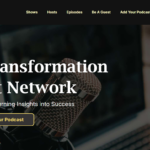Earlier this year I participated in a very special event in London, Inspiring Change: Women Transforming Business. I had the opportunity to dialog with an extraordinary set of global leaders and professionals in the room on business transformation through the lenses of business agility, impact and scale, and progressive leadership and culture.
This event inspired me to reflect across many years of leading and living business transformations. As I synthesized all of my experiences across sectors, industries, countries, and spans of time, I discovered that my greatest lessons were the meta ones and the human ones. The digital technology that was at the center of these transformations barely registered in my recollections of success factors or what mattered most in the end.
I am reminded again and again that digital transformation is just business transformation. Whether we’re leveraging technology at the heart of our business model and strategy and/or to better enable our operations, it’s still just all about the business: how we compete, how we deliver value, how we co-exist within the broader business ecosystem, and how we operate effectively and adapt to change over time.
As the Institute for Digital Transformation has always stated and stood for from the very beginning, digital transformation is defined by a collective set of beliefs and guiding principles for how an organization can drive and sustain a transformative organization, supported by technology.[i]
Here is a summary of some of my key lessons learned from digital transformations.
A Few Lessons Learned from Digital Transformation
Transformation typically includes transforming how we transform.
At least at this juncture, many organizations I work with have a dual set of transformations going on simultaneously, even if it is not explicitly stated. There is of course the actual focus of a transformation(s), such as shifting to a more digitally-driven business model or digitizing products and experiences. However, alongside that there are also often major efforts and mindset shifts around how the organization responds to change and builds agility. This is often reflected in efforts such as the adoption of agile frameworks and the shift from project to product, but also goes further to include creating a cohesive, contemporary, multi-disciplinary strategy to execution process to deliver strategic change and redesigning into a composable enterprise.
This secondary transformation is tremendously important for organizations to be able to continually and effectively implement change with agility and resilience in an increasingly uncertain and disruptive world. However, we always need to be mindful of helping our employees, partners, and customers or constituents manage through the magnitude of change that is happening all at one time.
Business architecture is a critical foundation for successful transformation.
Business architecture is a set of business blueprints that represent an entire organization and the ecosystem in which it operates. Blueprints create shared understanding and activate change and that is the role business architecture plays within a transformational context.
As an architect and designer of organizations and transformations, I have seen firsthand the value of the structure and enterprise mindset that business architecture brings to transformation activities. It provides the macro level framework to structure an entire transformation and define business ownership around it that transcends silos. It provides reusable building blocks to define an organization for efficiency and agility in concert with other design disciplines. Business architecture also provides the golden thread to translate business direction into a coordinated set of actions across people, processes, information, and technology – and keeps investments and implementation aligned back to business direction on an ongoing basis.[ii]
A big why is a critical motivator and uniter for transformation.
As humans, we create our own meaning and reality. The most successful and inspiring transformations I have seen were purpose driven. There is nothing more effective or motivating than working towards a clear, important, and shared purpose that transcends silos.
For example, a focus on the customer can be a great uniter. I have seen organizations that oriented around the customer and customer experience with passion and authenticity – and could articulate what the vision looked and felt like – were able to inspire people to come together for a purpose greater than themselves. When purpose touches peoples’ hearts and minds, we collaborate better across silos, make holistic decisions based on what is best for the customer and the enterprise, and we can even work more effectively when we’re working for a reason that is bigger than a paycheck.
Our transformations of today create the world we will live in tomorrow.
As an architect of transformation, I have often reflected on my impact and enablement of the bigger picture. Each organization is focused on their own goals and realities, but I often ask myself: will the sum of all these transformations across all these organizations collectively add up to a world we all want to live in and leave for future generations?
This brings me again back to the importance of purpose – and the importance of setting the right purpose and intentions for our organizations and their transformations. Are we creating products and services that are valuable, sustainable, and healthy? Are our organizations ethical, transparent, accountable, sustainable, and resilient? Are our workplaces diverse, inclusive, and meaningful for people to spend their most valuable currency of time in? How should the role of business within our societies continue to evolve?
Among all the excitement and hype of new technologies and transformation, these are the questions that will always lie at the heart of what we are really doing. Digital transformation is business transformation.
What It All Means
One meeting and one day at a time, it is easy to lose sight of the bigger picture that we are contributing to. It is natural to get swept away in the momentum of the activities and deadlines, and the latest business and technology trend. However, each of us has the power to choose and influence and lead from our position.
Technology will magnify and accelerate who we are and what we think. So, let’s keep taking time to pause and zoom out to the bigger picture. Let’s focus on the vision, the value, and the world that we are collectively co-creating. And let’s focus on how we show up and make a difference for each other every single day as leaders, team members, and humans. To the future!
[i] Please see the Digital Transformation Manifesto by the Institute for Digital Transformation: https://www.institutefordigitaltransformation.org/digital-transformation-manifesto/
[ii] For more information about this topic and how to move into action, please see additional articles on the Institute’s site here: https://www.institutefordigitaltransformation.org/about-the-institute/whynde-kuehn/
Tag/s:ArchitectureBusiness TransformationEmpathyManifestoOrganizational Change





